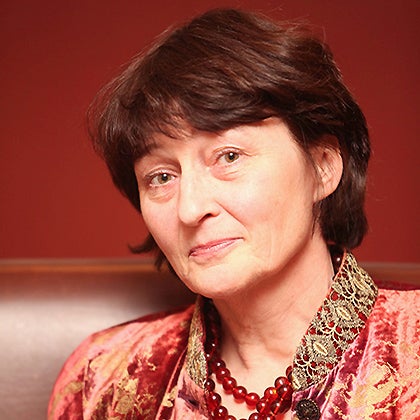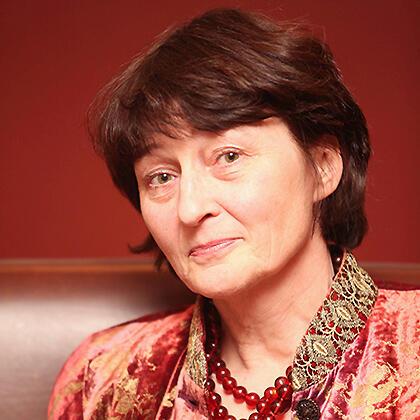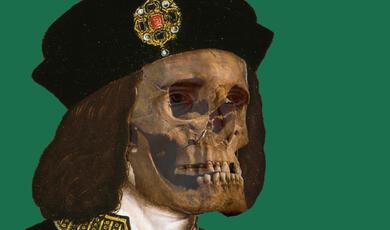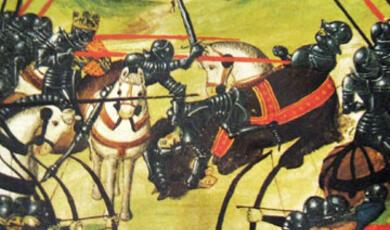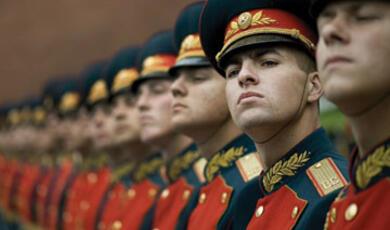Queen Victoria: Images of Power and Empire
Share
- Details
- Text
- Audio
- Downloads
- Extra Reading
This lecture will examine the images of power and empire projected by Queen Victoria over the course of her reign.
Beginning with her coronation, it surveys her depictions as a young queen. It looks at the transformation of her image after Albert’s death from devoted wife to grief-stricken widow. It examines portrayals of Victoria as grandmother of Europe and as Empress of India, and it concludes that the strongest image is that of the black-dressed Queen alone.
Download Text
Queen Victoria: Images of Power and Empire
Professor Jane Ridley
15th February 2023
Queen Victoria was a prolific writer. Each night in her journal she wrote 2,000 words, and it’s estimated that she penned 60 million words of journal during her lifetime. Her letters, both public and private, fill many volumes. The literature on Queen Victoria is vast, but little has been written about her use of images. When Queen Victoria came to the throne in 1837 she was only 18, but she already understood the importance of images of power.
At the time of her Coronation in 1838, Queen Victoria sat for portraits by fifteen artists. There was some uncertainty about the iconography that should be used for official portraits. Perhaps the most successful Coronation painting was the one painted by the American artist Thomas Sully. When Sully arrived in London from the United States, he had to wait his turn to paint the Queen; his was the 61st sitting of the year.
Breaking with the traditional Coronation painting of the monarch in robes with the Crown on one side, Sully’s portrait depicts the Queen wearing a crown but in almost informal pose. She looks back over the darkness behind her – the reigns of her wicked uncles, King George IV and King William IV – and light beckons as she stands on the steps of the throne. It is a new dawn. This image was not seen in Britain, as Sully took the two paintings which he made back home to the US. However, Sully found the Queen anxious to ‘dispatch’ her image abroad. Already she had learnt to use art as a way of communicating.[1]
Victoria married Prince Albert of Saxe-Coburg Gotha, her first cousin, on 10 February 1840, and within weeks they began discussions about commissioning a painting to commemorate their wedding. The painter was Landseer, best known for his studies of animals, especially dogs – both Albert and Victoria were dog lovers. Landseer had been appointed to give drawing lessons to the Queen; as her sketches show, she was an accomplished water colour artist.
Landseer’s wedding painting was Windsor Castle in Modern Times (1841-43). In the picture Albert brings the game that he has shot into the white drawing room at Windsor, thus bringing the man’s sphere of sport (and mud) into the Queen’s private sphere and the nursery of the infant Princess Vicky.
Note that Albert wears his blue Garter ribbon out shooting. This was fact not invention. Sir William Ross’s shows him proudly displaying the Garter which Victoria gave him on their marriage.
Landseer accompanied the royal couple on their Highland holidays, where he constantly sketched scenes of Victoria and Albert in the Scottish mountains. ‘It is quite a new conception,’ wrote Victoria. ‘No other Queen has ever enjoyed what I am fortunate to enjoy in our perfect happy life here.’ [2] Landseer’s paintings such as the Monarch of the Glen were a brilliant exercise in PR, spinning a narrative of the happy, healthy Highland life of the royal couple.
Landseer’s painting of ‘Windsor Castle in Modern Times’ failed to resolve the question, who is in charge, the Queen or the prince? Albert himself complained: ‘I am only the husband and not the master in the house.’ [3] Victoria was conflicted. She wanted to be a perfect wife, the angel in the house, and she worshiped Albert; but her wifely aspirations were undermined by her mission to be Queen.
The fashionable Austrian Court painter Winterhalter now became Victoria’s favourite artist, introduced by the Queen of the Belgians. In The Royal Family in 1846 he painted Victoria and Albert sitting side by side and wearing Court dress while their five children played. Victoria had seven of her nine children in the first ten years of her marriage, and this alone allowed Albert to take over most of the work of the sovereign.
The red curtains in the painting are suggestive of theatre, and the children are unposed and oblivious of the viewer. This is a royal family on show to the world.[4] It is also a diagram of the domestic dynamic. The Queen sits on Albert’s right as protocol required – she was the head of state - but she stares blankly out of the picture frame, while Albert’s gaze is fixed on Bertie, his son and heir. The royal couple’s fingers are lovingly entwined; but Albert’s position as head of the family is clearly signalled. He is the dominating, dynamic figure, protecting his wife from the outside world.
But it wasn’t all strife on the domestic front. Victoria enjoyed buying presents for Albert, such as Winterhalter’s Florinda (1853). This shows a group of beautiful women in a harem who were spied upon by Roderick the Visigoth – what does it tell us about their relationship?
In 1843 Victoria commissioned a painting of herself by Winterhalter as a gift for Albert’s 24th birthday. It’s known as the ‘secret’ or bedroom picture. It was not hung in a public space but in Albert’s Writing Room at Windsor. Victoria later recalled that this was ‘my darling Albert’s favourite picture’.[5] With her long, loose hair, this is an intimate image; but it’s also a fashion statement. As Colin Jones has shown in The Smile Revolution, royals were trained not to smile in order to hide black and rotten teeth. Recent advances in dentistry however, preserved white teeth, and Victoria’s half-parted lips tell us as much about her dentist’s handiwork as they do about her sex life.[6]
Winterhalter’s 1859 portrait of Victoria shows her in conventional monarch’s pose. She wears robes of state, and the Imperial State Crown rests beside her. Surrounded by columns signifying the stability of her reign, she looks out over Westminster, holding papers in her left hand – a gesture suggesting the harmonious working of crown and parliament in a constitutional monarchy.
Victoria thought this image ‘truly magnificent’ (there is a pair of Albert) and it became the official likeness. It was much copied.[7] The picture seemed to signal the stability of the monarchy; but this was soon to change.
Albert’s sudden death aged 42 on 14 December 1861 plunged Victoria into the greatest crisis of her life. She gave way to deepest grief. She refused to appear in public, shut up Buckingham Palace and retreated to Windsor. She neglected her official duties, opening parliament only seven times after 1861. She seemed palpably unfit to reign. Some thought she was losing her mind, but she clung with iron determination to the throne.
A wag posted a notice outside Buckingham Palace: ‘These commanding premises to be let or sold in consequence of the late occupant’s declining business.’[8] Gladstone the PM attempted to compel the Queen to appear. A Republican movement emerged. ‘What Does She Do With It?’ shrieked a radical pamphlet, accusing the Queen of hoarding the money voted by Parliament on the Civil List. This was the worst crisis for the monarchy until the Abdication in 1936.
Victoria responded to her critics by commissioning a painting from Landseer, who was ordered to represent her ‘as I am now, sad and lonely’.[9] Once again she was using art as a weapon. Her Majesty at Osborne 1866 shows the Queen reading the letters from her official red box while sitting side saddle on her black pony. Two of her daughters, Princess Helena and Princess Louise, look on.
This attempt to appeal to the sympathy of her subjects backfired. When the painting was exhibited at the Royal Academy, it produced sniggers from the public. Outraged critics complained at the Queen’s unseemly closeness to her Highland servant, John Brown, the man who was holding the pony. There was gossip about ‘Mrs Brown’, as she was nicknamed.
Photography gave the Queen a better way of controlling the narrative. Albert had been one of the first to recognise the importance of photography, as we can see in this 1861 photo of the royal couple, taken shortly before Albert’s death. At the wedding of Bertie Prince of Wales and Princess Alexandra of Denmark in 1863, the royal photographer was commissioned to take photos. These images vividly communicate the Queen’s grief, locked into a silent dialogue with the marble bust of her beloved Albert, and incidentally stealing the show from the happy couple.
Victoria’s political power declined in the second half of her reign. After the 1867 Reform Act, power shifted to parliament. Prime ministers were no longer appointed by the monarch. But as the queen’s executive power shrank, her ornamental or ‘soft power’ increased.
She found new spheres of influence. One was the empire and especially India. The Queen’s extraordinary relationship with India has been analysed by Miles Taylor. In Empress he explores the paradoxes about Queen Victoria and her Indian empire.[10] She never visited India. But her image was everywhere – on the coinage, in photographs and embodied in countless statues. She was the Mother of India.
Not all her motives were disinterested. Victoria was determined to bag the Koh-i-Nor, and she insisted that it should be presented to her after the Sikh wars. Winterhalter’s painting of her wearing the Koh-i-Nor (1856) is an image of power, plunder and greed: the Queen showcases what was at that time the biggest diamond in the world.
In 1876 she persuaded the PM Disraeli to make her Empress of India by passing the Royal Titles Bill. She now signed herself VRI (Victoria Regina et Imperatrix). ‘It suits oriental ideas,’ said the Queen Empress.[11]
Victoria acquired an Indian servant, Abdul Karim, who became her Urdu teacher and private secretary. The members of her household fiercely resented the Munshi, as they called him, because of his intimacy with the monarch. There was an element of racism here. But this photo, commissioned by Abdul Karim in 1897, provoked an outcry. It subverts the power relationship – the Queen, who should be giving the orders, is here a small, crushed figure who seems to be controlled by the domineering Munshi towering over her.
Victoria’s other realm was her extended family. This painting by the Danish painter Laurens Tuxen shows the Queen Empress at her 1887 Golden Jubilee. Albert’s bust still appears, but it has now receded to the mantlepiece. Certain members of the extended family refused to sit next to one another. The Danish Alexandra, who never forgave the Prussians for invading Denmark in 1864, refused to speak German or sit next to the Crown Prince of Germany.
Victoria thought this a ‘charming’ family painting. But there is much more to it than that. It signalled the dynastic power of the black-dressed Queen. The tiny figure at the front of the picture, playing with her grandchildren, is not a typical old lady. On the contrary, the grandmother of Europe was a major player in power politics. Victoria dominated the family networks of correspondence which were the glue that held the dynasties together.
Victoria liked nothing better than sitting beside the bed of her granddaughters when they were in labour. She witnesses the birth of Prince Phillip’s mother, Princess Alice of Battenburg. Her letters to the Hesse family show how concerned she was about her grandchildren and particularly their marriages. Matchmaking was a favourite pastime. One of Victoria’s 42 grandchildren was Kaiser William II of Germany; another was the tsarina of Russia, Princess Alexandra of Hesse. The Queen’s influence with her difficult grandson William II was a key factor in the diplomacy of Lord Salisbury.
Victoria’s court was one of the most bizarre in Europe. At Windsor you walked down hushed corridors, one door after another noiselessly opening, before reaching the Queen’s private apartments. Here in a room smelling of orange water and hung high with photographs of her dead relations, the Queen sat with her dogs at her feet perpetually writing.
The paradox was that in spite of – or perhaps because of - her seclusion, Victoria’s popularity soared in the 1880s and 1890s. She was rarely if ever seen by her subjects, yet she was acknowdeged as the mother of her people. The image of the Widow of Windsor, the grieving widow forever wearing black mourning, was an image of power. This was a domestic sovereign, committed to the welfare of her people.
© Professor Ridley 2023
[1] Queen Victoria and Thomas Sully, https://www.metmuseum.org/toah/hd/tsly/hd_tsly.htm
[2] Queen Victoria’s Journals online, 9 September 1850. Elizabeth Longford, Victoria R.I. (Weidenfeld & Nicolson, 1964), pp. 215-6.
[3] Longford, Victoria, p. 148.
[4] Royal Collection website, https://www.rct.uk/collection/404860/florinda
[5] Queen Victoria’s Journal website, 2 February 1873.
[6] Colin Jones, The Smile Revolution in 18th Century Paris (OUP, 2014).
[7] Royal Collection website, https://www.rct.uk/collection/405131/queen-victoria-1819-1901-0
[8] Jane Ridley, Victoria: Queen, Matriarch, Empress (Allen Lane, 2015), p. 68.
[9] Ridley, Victoria, p. 76.
[10] Miles Taylor, Empress: Queen Victoria and India (Yale University Press, 2018).
[11] Ridley, p. 99.
Part of:
This event was on Wed, 15 Feb 2023
Support Gresham
Gresham College has offered an outstanding education to the public free of charge for over 400 years. Today, Gresham College plays an important role in fostering a love of learning and a greater understanding of ourselves and the world around us. Your donation will help to widen our reach and to broaden our audience, allowing more people to benefit from a high-quality education from some of the brightest minds.


 Login
Login
